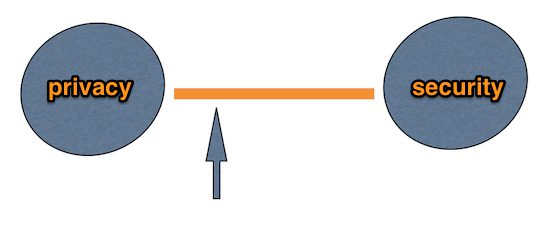Having just attended the Freedom & Solidarity Forum, celebrating the 70th anniversary of the D-Day landings, one of the recurring themes of the day was transparency. In today’s connected world, the notion of transparency is being discussed — if not called into question — in the context of the political and economic relationships between “the Allies.” The subject is highly sensitive in light of the inter-state spying scandals (NSA…). Freedom is a founding and common value shared throughout the WWII allies (not including Russia). In freedom, there are the core premises of freedom of expression and freedom of enterprise. People want those freedoms and, as part of it, want to keep their privacy. In order to enable that freedom, there is a sine qua non need for security.
There is a tension, if not a de facto opposition, between privacy and security. How much privacy does one need to give up to ensure the security of all? The answer varies according to the person, the country and the culture.

The word that seems to stand in between privacy-security is trust. The challenge is to ensure security while protecting people’s freedom and their privacy. And the million dollar question is who has a hold on the reins? Who do we trust? Among the important ways to gain trust is transparency. As an article from Wired wrote, “transparency is the road to trust.” However, complete transparency is neither possible nor desirable. So, just how much transparency does one need? The answer sorely depends on the eye of the beholder.
The business of security
If the notion of security typically relates more to our physical wellbeing (i.e. safety from acts of violence, terrorism, warfare), the premise takes on new weight and importance when it comes to our security online. Protection of one’s online presence and of one’s digital data is a burgeoning issue. In a business context, on the one hand, security is important for purposes of guarding under wraps confidential information. It also is extremely important as it pertains to customer data — both financial and personal. If companies wish to capitalize on the big data trend to provide legitimately personalized services and to foster a stronger relationship, customers must feel sufficiently trustworthy to hand over their details.
Who you gonna trust?

But, the latent distrust of companies and brands is a real issue that marketers don’t always take seriously enough. According to a recent survey commissioned by HyTrust, 72.5% of consumers polled said that they don’t believe organizations care about keeping customers’ private data safe and secure. I will note that the question was phrased in the following manner:
“Do you REALLY believe organizations care about your private data and keeping it safe and secure?”
Even if the wording of the question were perhaps a little less ‘dramatic,’ a very large number of people are reticent to hand over their data. Attempts to get that data through less ethical or transparent ways will only heighten (and justify) the mistrust.
Why business must care about transparency
Where businesses and brands can earn some trust is by finding ways to be more transparent about why, what and how they intend to use the data. N.B. A lot of small print is not the answer. Firms need to go to extra lengths to demonstrate how secure the data is. In addition, brands need to be upfront on how they plan to bring benefit to the customer in exchange for the data. Disney’s refurbishment of their Florida theme park (MyMagic+) with a clear value proposition for the data handed over is a great example.
Earning the right
In Chinese, the ideogram (above) is composed of a person and their word. A person must keep his/her word to gain trust. In reality, however, the word must be proven by actions. With these actions, others will speak to the trustworthiness of your brand, creating the word of mouth that is the real building block of trust. In short, for brands to earn the right to one’s information, they must ensure the security of the data and provide total respect of their customer’s privacy. Providing a window into how that will happen is probably a good way to start — and for brands with a low trust factor going in, this becomes a strategic necessity. {Tweet this}
Your thoughts?











Trackbacks/Pingbacks